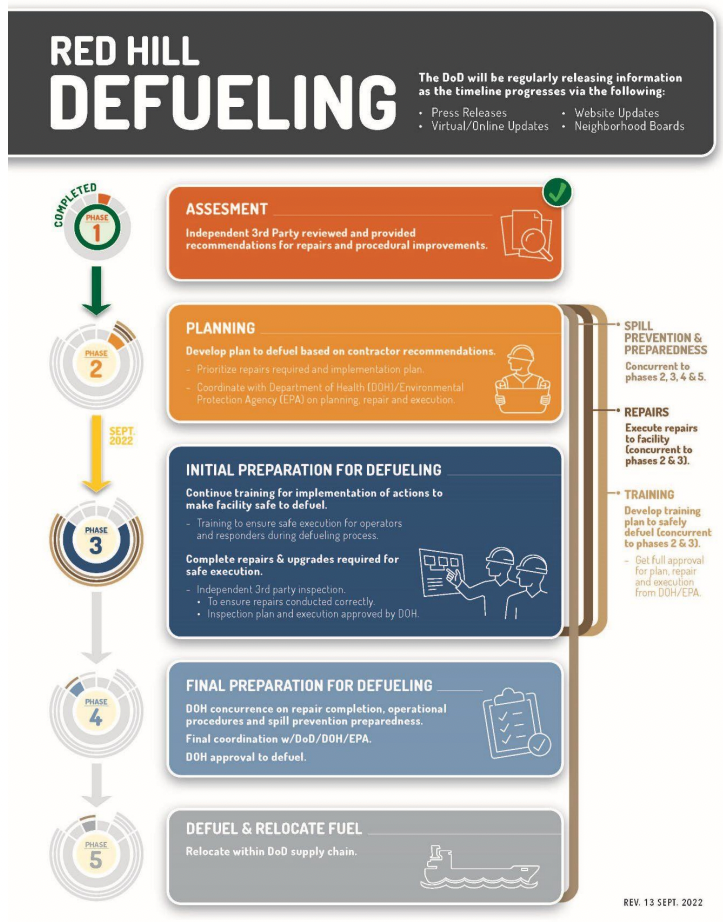
The Hawaii Department of Health cleared the Department of Defense to defuel three pipelines at the Red Hill Bulk Fuel Storage Facility — one of the beginning phases in the DoD’s plan to remove all fuel from the site.
The health department announced that it would conditionally approve the pipeline defueling phase of the DOD’s plan on Friday, according to a news release. The Navy will begin removing fuel from the three pipelines in the next week.
“The Department of Health is focused on ensuring the Navy defuels Red Hill safely,” Deputy Director of Environmental Health Kathleen Ho said in the statement. “DOH staff completed a careful review of the unpacking plan, observed spill response drills, and required additional environmental control measures be put into place before unpacking can begin. We continue to push for the defueling and closure of the Red Hill facility to happen as quickly as possible with safety as our first priority.”
There are approximately 1.08 million gallons of fuel remaining in pipes in the facility, USNI News previously reported. One line has approximately 220,000 gallons of fuel, one has 170,000 and the third has 690,000.
The DoD will perform the pipe defueling in four phases, starting with pre-operation planning followed by valve maintenance and pressure equalization. The DoD will use gravity-down draining to remove the fuel.
Each pipe will need two to three hours to drain, USNI News previously reported. Removing the fuel via a vacuum truck will take three to five days.
 It is unclear where the fuel will go, Lene Ichinotsubo, acting program manager for the solid and hazardous waste branch of the Hawaii Health Department told Honolulu Civil Beat. The Navy mentioned a location on the West Coast or an undisclosed location on Oahu, Ichinotsubo said.
It is unclear where the fuel will go, Lene Ichinotsubo, acting program manager for the solid and hazardous waste branch of the Hawaii Health Department told Honolulu Civil Beat. The Navy mentioned a location on the West Coast or an undisclosed location on Oahu, Ichinotsubo said.
U.S. Indo-Pacific Command commander Adm. John Aquilino did not detail in July where the fuel would go once it’s removed from Red Hill.
According to the initial defueling plan, marine ship diesel fuel, which accounts for about 12.5 million gallons of the fuel, and 63 million gallons of aviation jet fuel, will be used in Hawaii. The West Coast will receive the remaining 30 million gallons of aviation jet fuel.
In approving the pipe defueling, the Hawaii Health Department laid out five steps that the Navy must follow, according to the conditional approval letter signed by Ho.
The first requirement is that the Department of Defense responds to any outstanding health department requests and that the DoD shows how it sealed off the drains. The Navy will also host the health department for a site visit before it defuels the pipes and complete training for those workers completing the defueling.
The Hawaii Health Department also laid out steps for spill prevention, which included completed training, a site visit and protecting pathways that lead to the drinking water aquifer, according to the health department’s release.
The announcement comes shortly after a visit by Defense Secretary Lloyd Austin, who met with Rear Adm. John Wade, commander of the Joint Task Force – Red Hill, in Hawaii and toured the facility.
“Defueling and closing Red Hill is the right thing to do – for our service members, our families, the people of Hawaii, the environment and our national security,” Austin said in a release about his visit. “We are moving out and will defuel this facility as quickly and safely as possible. I am confident that Rear Adm. Wade will effectively lead this important effort and that he will work closely with the Hawaii Department of Health, the Environmental Protection Agency, and the community.”
The DoD continues to update its plan to remove the entirety of Red Hill’s fuel. The Pentagon most recently laid out a potential plan that would allow it to shrink the amount of time it would need to remove all fuel – the final phase of the defueling plan – from 120 days to 30 days. The plan had already been shortened by six months so that defueling would end by July 2024 rather than December 2024.





